- Researchers and conservationists struggle to view fine details of their study subjects within the context of the surrounding environment.
- Using your camera, the GigaPan mount system snaps hundreds of individual photos to create a composite image that shows both a study site and the fine details of its individual components.
- The resulting images are huge but unusual, as they generate a unique sense of scale and context of “sites” ranging from microscopic to outer space.
Scale has traditionally been one of the most challenging aspects of science and conservation photography. Detail is almost always important to scientists, but macro images lack the context and perspective of panoramas.
At the onset of a study, it is not always possible to know what elements of an ecosystem will prove to be of particular interest, and therefore determining which elements to focus on can be difficult. Add to these concerns the challenge of minimizing human impact in observational studies. How can scientists study an entire system in detail without interfering with system functioning?
GigaPan, short for gigapixel panorama, has emerged with a new approach to observing a system remotely, from various scales. The company, a spin-off of a collaboration between NASA and Carnegie Mellon University, is bringing Mars Rover technology to Earth.
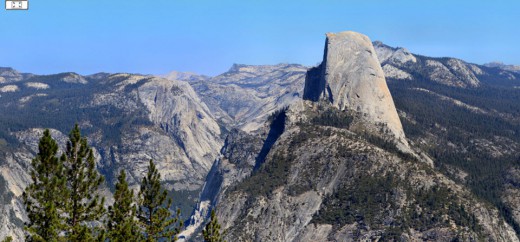
Each panoramic “gigapixel” image is composed of many smaller images and is created by photographers who attach their cameras to GigaPan robotic mounts and program the image specifications. The mounts then pivot slightly while snapping hundreds, even thousands, of photos, which are stitched together using GigaPan Stitch software. The result is a giant high-definition panoramic comprised of billions of pixels, which the user can explore with mapping technology similar to Google Maps. Each image is comprised of hundreds or thousands of tiles, which the viewer uses to zoom and move at fine-scale.
Initial Investment
Photography: GigaPan has developed three robotic mounts: the EPIC, EPIC 100, and EPIC Pro. The EPIC (at US$319) works for compact digital cameras, while the EPIC 100 (at $479) supports slightly larger point-and-shoot cameras. The EPIC Pro (at $995) is the largest model, and it supports DSLR camera and lenses up to 10 lbs.
Panorama: GigaPan Stitch is free with purchase of any EPIC mount. GigaPan Stitch.Efx, the upgraded version of the basic photo stitching software, can be purchased with an EPIC for an additional $70 or purchased separately for $149. The software allows users to upload and view images at gigapan.com, as most compilations contain far too much data to process on a hard drive.
Full use of GigaPan requires a digital camera with tripod, memory card, and USB reader or camera cable; EPIC mount and batteries; Stitch software; and a computer with at least 1GB RAM. You can learn more here or explore the various options here.
Applications
Researchers, educators, and nature photographers from various countries have begun testing and adopting the relatively inexpensive technology for everything from ecosystem monitoring to inspiring empathy for the natural world through unusual imagery. Here are some examples:
Biologists use GigaPan in field studies to maximize and complement data collection while minimizing observer interference. For example, Alex Smith at the University of Guelph uses the system to collect ecosystem data while studying insects on Costa Rican volcanoes. The inset photo demonstrates the detail available from the larger photo.
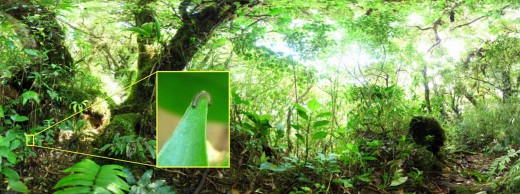
Jason Straka recorded ecological context for his insect collection work around a sink hole near the Georgian Bay in Canada (below left). He discovered a beaver dam at the site within the gigapixel panorama (below right).

Defenders of Wildlife, in partnership with Northern Jaguar Project, uses GigaPan imagery to monitor jaguar habitat in the Northern Jaguar Reserve in Sonora, Mexico. Defenders Senior Southwest Representative Craig Miller studies vegetation and erosion to determine the effectiveness of livestock removal on jaguar habitat restoration. He and colleagues also use this technology to monitor the U.S.-Mexico border to better understand how border infrastructure affects wildlife movement. The research team hopes to integrate the GigaPan images with camera-trap stills and videos to present a more comprehensive representation of northern jaguars and their habitat. The inset photo shows the detail available from the larger photo.
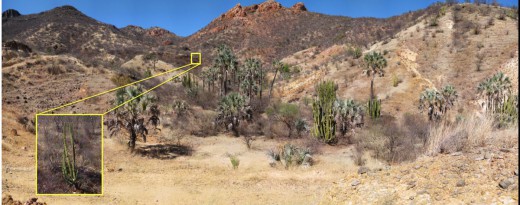
In Australia, scientists at CSIRO Climate Response use GigaPan technology to document the effects of climate change on sea mammal and seabird populations (below). They use the high-resolution images to monitor population details, such as nest locations, chick presence, and adult arrival times, over the extent of the colony.
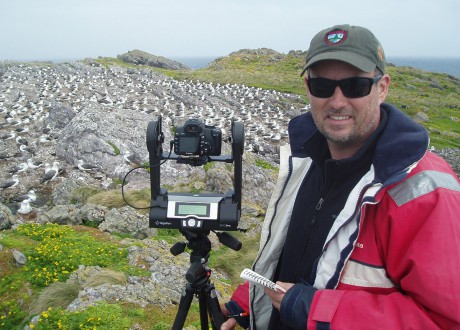
Underwater photographer Jason Buchheim has invented an iPhone app that precisely tracks his camera’s location, allowing him to create wraparound 3-D images, as well as a 3-D stereo viewer for GigaPans. His photo (below) shows Salema fish schooling tightly to avoid predation in the Galápagos Islands on an Odyssey Expeditions Tropical Marine Biology Voyage.
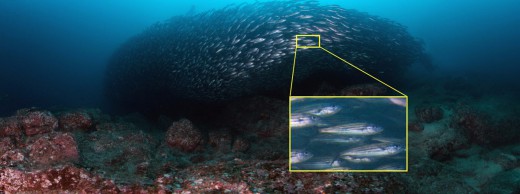
Conservation educators have used the imaging system to help students understand environmental context, as well as to inspire public appreciation of nature. Two schools in southwestern Pennsylvania used GigaPan images and discussion platforms to compare and analyze water quality and remediation efforts in their neighborhoods. This exploratory study helped students in both communities explore the impacts of Marcellus Shale drilling, fostering a sense of environmental appreciation.

Enormous digital GigaPan prints of Hawaiian ecosystems have also been used as wallpaper panoramas in universities across the archipelago to promote a sense of environmental pride, to engage students and faculty in conservation efforts, and to foster partnerships among interested individuals, organizations, and communities.
Limitations
Users of this system have acknowledged several concerns about this system, which include difficulties with camera programming and software use, as well as the bulk of the mount itself. Users must read a detailed instruction manual and be willing to experiment in order to determine which camera settings work best for their objective. The mount itself is prone to vibrations, particularly in windy conditions, which may result in blurry images, especially if the camera is set incorrectly.
Finally, the sizes of the EPIC mounts (the EPIC Pro in particular) prohibit most photographers from bringing them along “in case”; GigaPan use must be planned. This may deter some users from lugging the mounts into the field in addition to their lenses, tripods, research materials, and other equipment. The post-processing — matching and stitching so many pixels together — is also more laborious than just snapping a single photo and can take days to complete.
Summary
The system has some kinks to work out, and researchers must determine if the initial investment is worth the product; each user must assess whether a high-resolution panoramic image will be useful in his or her work. So far, the application of GigaPan remote mounts and software spans the spatial spectrum from satellite imagery to Scanning Electron Microscope studies, in fields as diverse as cosmological simulations and archeological preservation. GigaPan may become an increasingly powerful tool for communicating information to improve both scientific research and appreciation for the natural world, as is one of few options in the cost range.
Learn more
Explore thousands of GigaPans.
Watch Chris Bartly, a robotics software engineer at Carnegie Mellon University and GigaPan team member, explain the technology.